A question you need to answer before buying a gun safe.
We hope by now you know if you own a gun, you need to buy a gun safe. Before you get a gun safe, you need to figure out where to put it. The place you will put the gun safe in will determine the shape, size, and weight of the gun safe.
There are many factors you need to consider before you get yourself a gun safe. In this article, we will cover all the aspects you need to keep in mind while setting up a gun safe in your home. This guide should be used as your checklist to decide where to place your safe.
Pre-requisites of Buying a Gun Safe
Before you buy a gun safe, you need to have clarity about a few things. These are the different types of gun safes in the market.
- In-Wall Gun Safes
- Hidden Gun Safes
- Car Gun Safes
- Under Bed Gun Safes
- Heavy Duty Gun Safes
- Corner Gun Safes
- Truck Gun Safes
- Nightstand Gun Safes
Other things you need to consider are the number of guns you own, their lengths and will you be keeping other valuables in your gun safe like cash, jewelry, important documents, or electronic equipment?
Once you’ve answered these questions, you need to determine how big a gun safe you want. Gun safes have different ratings for being fireproof, and for their locks. You also need to think about the chances of burglary, fire, floods, and humidity levels in your neighborhood. There are safes which cater specifically to these kinds of threats. The prices vary depending on the type of the gun safe you go for.
Know Your Home
The gun safe you choose will depend on where you will be installing it. Everyone doesn’t have an unlimited access to storage space in their homes or offices. You need a gun safe which will fit into your desired space.
Based on the places you can store a gun safe in your home, here is an overview of the levels of burglary, flood, fire and humidity threats.
| ROOM TYPE | SPECIFICS | HUMIDITY / TEMPRATURE | THEFT RISK | FLOOD RISK | FIRE RISK |
|---|---|---|---|---|---|
| Basement | No Washer / Dryer | High | Low | High | Medium |
| Basement | With Washer / Dryer | High | Low | High | High |
| Bathroom, 1/2 | 1st Floor | Medium | Low | Medium | Low |
| Bathroom, 1/2 | Upper Floor | Medium | Low | Low | Medium |
| Bathroom, Full | 1st Floor | High | Low | Medium | Low |
| Bathroom, Full | Upper Floor | High | Low | Low | Medium |
| Coat Closet | 1st Floor | Low | Low | Medium | Low |
| Coat Closet | Upper Floor | Low | Low | Low | Medium |
| Garage | Attached | Medium | High | Medium | Medium |
| Garage | Unattached | Medium | High | Medium | Low |
| Interior Hallway | 1st Floor | Low | High | Medium | Medium |
| Interior Hallway | Upper Floor | Low | High | Low | High |
| Kitchen | 1st Floor | Medium | Medium | Medium | High |
| Kitchen | Upper Floor | Medium | Medium | Low | High |
| Laundry Room, No Dryer | 1st Floor | Low | Low | Medium | Low |
| Laundry Room, No Dryer | Upper Floor | Low | Low | Medium | Low |
| Laundry Room, With Dryer | 1st Floor | Medium | Low | Low | Medium |
| Laundry Room, With Dryer | Upper Floor | Medium | Low | Low | Medium |
| Living Room, No Fireplace | 1st Floor | Low | Medium | Medium | Medium |
| Living Room, No Fireplace | Upper Floor | Low | Medium | Low | High |
| Living Room, With Fireplace | 1st Floor | Medium | Medium | Medium | Medium |
| Living Room, With Fireplace | Upper Floor | Medium | Medium | Low | High |
| Master Bedroom | 1st Floor | Low | High | Medium | Medium |
| Master Bedroom | Upper Floor | Low | High | Low | High |
| Mater Bedroom Closet | 1st Floor | Low | High | Medium | Medium |
| Mater Bedroom Closet | Upper Floor | Low | High | Low | High |
| Office | 1st Floor | Low | Medium | Medium | Low |
| Office | Upper Floor | Low | Medium | Low | Medium |
| Other Bedroom | 1st Floor | Low | Medium | Medium | Low |
| Other Bedroom | Upper Floor | Low | Low | Low | Medium |
| Other Bedroom Closet | 1st Floor | Low | Low | Medium | Low |
| Other Bedroom Closet | Upper Floor | Low | Low | Low | Medium |
Installing a Gun Safe
Before we get into where to put your gun safe, let’s talk about how to set it up. Knowing how to install a gun safe will help you in finding the best place to put it.
These are the things you need to install the gun safe:
- Location – Location is what we’re exploring in this article. The location of putting a gun safe can vary depending on your convenience, how many times you access it in a day, what threats do you what to save it from.
- Path to move the gun safe in – After you’ve bought your gun safe, you need to move it into your home and to the place of installation.
- Floor – Some gun safes can be heavy. You need to make sure your floor can handle the weight of the safe.
- Level the gun safe – You need to level the gun safe before installing it.
- Bolt the gun safe – Bolting is a must if you need complete security for your gun safe.
- Electrical connection – You might need electrical connections for your gun safe depending on where you install it.
Path To Move The Gun Safe In
Once you’ve bought your gun safe, you need to get it from your front door to where you want to install it. Depending on your needs, your gun safe can range from a bed side handgun safe to a full sized safe. The bigger the safe, harder it will be to move it and install it.
If you have never moved a gun safe or something this heavy (some gun safes can weigh more than 500lbs) before, consider hiring a professional. You might even need additional hands if you want to install the gun safe on the first floor of your house.
If you are adamant about moving the gun safe on your own, rent some moving equipment. Lay plywood on the floor to save your floor and the door thresholds. If there are more than three stairs, you will need professional help and equipment.
Floor To Support A Gun Safe
Just like humans, not every floor is created equal. It is especially true for the first and higher floors. Structures and things are rated by two type of weights: dead/static loads and live loads. Humans are live loads which can move around. Dead loads, like gun safes, on the other hand, are restricted and can’t move around.
If you want to install a gun safe on the first floor or higher, you need to get your floor checked so you know how much weight it can handle. Generally, you shouldn’t store a gun safe which weighs more than 1000lbs on higher floors. If you’re buying a gun safe through a dealer, you can ask him to check the strength of your floor.
You can also do this by yourself, to calculate the load bearing capability of your floor, you’re going to need to know the effective size, type, material, and spacing of the floor joists. You need to know the floor joists size because they might be overused from years of using. The joist might also get notched out while plumbing, electrical works etc.
If you want to install the gun safe on the ground floor or a basement, all you need to do is to measure the area. Once you have the details, you can take it to a carpenter or use an online calculator to know if your floor can handle the weight.
The floor surface also plays an important role in setting up a gun safe. It is much better to install the gun safe on a hard surface as compared to the soft surface like a carpet or other cushioned surface as it is harder to insert a pry tool under a safe if it is placed on a hard surface.
In case you’ve selected a gun safe which is more than 2000lbs and your floor can’t support it, there is a solution for it. You can get rid of some features to reduce the weight of the vault. For example, a gun safe with UL certification for being fire proof can be 1000lbs heavier than a non-UL approved fire safe. The non-approved gun safe will also be cheaper than the other gun safe. You can use the saved money to install a sprinkler over your gun safe.
Level The Gun Safe
Leveling a gun safe is a must before you bolt it down to your floor. Below are some primary reasons for leveling the gun safe.
- The lock and the door can malfunction if the gun safe is not leveled and is kept at an angle. In this situation, you will need to call a lock smith to open the door.
- The safe and the door can get misaligned if they’re not kept at a level for a long time. The misalignment will make the safe useless.
- If your safe is not leveled, the door might open and shut on its own. This can hurt your guns and you. If you have a heavy gun safe like a true gun safe or a vault door, you can even lose your fingers or hand if the door shuts on its own.
You shouldn’t think of bolting the gun safe to your floor directly. Doing this will reduce the life of your gun safe and floor. Always use shims while installing a gun safe so it doesn’t wobble.
Anchoring Your Gun Safe
Anchoring your gun safe to the floor is a must. If you haven’t bolted down your gun safe to the floor, your vault can be easily moved around and carried away. Moving around a big gun safe isn’t much work for the experienced. Watch the video above to learn how to move, remove the pallet and level a gun safe.
If your gun safe doesn’t come with bolts, make sure you use ½” bolts to screw down the vault. If your gun safe isn’t leveled and is wobbling, use shims to stop the rocking. Make sure you bolt all the four holes inside the gun safe. Also, placing the gun safe against a wall is a safer option since the burglars can’t tilt it and tip it over.
Before you start drilling and bolting the gun safe to the floor, it is very important to make sure there aren’t any water, sewer, forced hot water heating pipes or wires under the floor. If you’re not sure about the location of the pipes or wires in your home, consulting someone can save you a lot of possible trouble.
Anchoring A Gun Safe To A Concrete Slab Floor
Concrete slab floors can prove to be the best place to bolt down your gun safes. Concrete slab floors provide the most security since they are one of the hardest surfaces you can anchor your vault to. There is a drawback to the concrete floor though. Concrete releases moisture which can corrode the bottom of your gun safe.
There are many ways to combat this problem. You could insert a hard rubber between the safe and the concrete floor to give space for the moisture to pass. Some people also use hockey pucks to add some gap in between the safe and the floor and then bolt the safe to the concrete slab through the pucks. We do not recommend leaving a gap between the safe and the floor which would leave an opening for pry tools.
Post tension concrete slabs – There is a specific type of concrete slabs known as the post tension concrete slabs which cannot be drilled through. The post tension concrete slabs got their name because they have high strength steel cables running through them under thousands of pounds of pressure. If this kind is slab is drilled and a cable inside it is damaged, it can fail and destroy everything which comes in its way. If you have the post tension concrete slabs, it should be marked “Post tensioned slab, do not drill cut or core.”
If you’ll be drilling through a concrete slab floor, you’ll need a hammer drill. You will waste a good part of your evening drilling with a traditional drilling machine. Your gun safe needs a hole too large and too deep to drill with a masonry bit and traditional drill. If you don’t own a hammer drill, borrow one or pay an expert to help you with it.
Concrete Anchors
Since you’ll be bolting the gun safe to concrete, normal anchors won’t cut it. The moisture released from the concrete will eat away the anchors. You will need zinc-plated or galvanized anchors. Stainless steel anchors will also be a great option.
Here are a couple of anchors you can use to secure a gun safe to concrete. Don’t waste your time and energy with a traditional drilling machine. Get a hammer drill and make sure the concrete slab isn’t a post tension concrete slab.
Female Concrete Anchors
Female type of anchors are difficult to install when securing a gun safe to concrete. The female anchors are like lag bolts and drop in anchor shields. Once you drill them into the concrete they will make bigger holes compared to other types of anchors. The advantage of this type of anchors is, once you remove the bolts, there will be nothing sticking out of the floor.
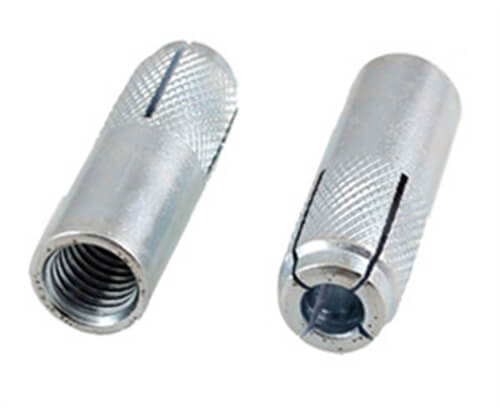
How to install a gun safe with female anchors?
- Set the safe where you want it
- Mark the position for the holes on the floor through the gun safe
- Move the gun safe away
- Drill the holes for the shield of the female anchors with a hammer drill
- Install the shield
- Insert the bolts into the shield to make sure everything is fine
- Remove the bolts, bring the safe into position and bolt down the safe to the concrete floor
Once you have the female anchors in place, it is close to impossible to move the gun safe. In case you have to move the gun safe, you will need to unscrew the gun safe by removing the bolts and nothing will be sticking out.
Male Concrete Anchors
Installation of the male concrete anchors isn’t as complicated as in the case of the female anchors. You don’t have to move the gun safe away to drill holes in the concrete. It can be done through the gun safe. Two types of male concrete anchors are useful while installing a gun safe.
- Wedge anchor studs
- Strike anchors
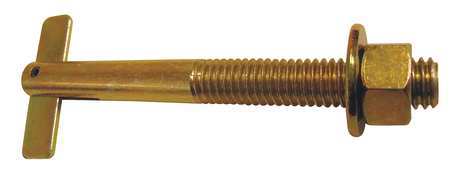
You can buy these male concrete anchors at many places including retail stores and online on sites like Amazon. Make sure your anchors extend at least 5 diameters into the concrete after drilling. Anything longer than this will be poking out inside your gun safe. Shorter anchors can make it easier for the burglars to rip of the gun safe from the concrete slabs.
While drilling for the male anchors make sure you drill a little deeper in the concrete as the male anchors are not made to be removable. Following are the ways to take out the anchors in case you need to move the gun safe.
- Hammer down the anchor completely into the concrete. This was the reason why you were asked to drill deeper than actually required.
- You can cut off the stud to level the surface of the concrete.
- Pull it out – a male anchor stud is stronger than the concrete. You will be able to pull the anchor out in most cases. You will need to fill up the patch made in the concrete.
The absolute right size for the anchors (both female and male) will depend on the contents of your floors. You need to make sure you don’t damage the piping or wiring of your house while drilling in the anchors.
Anchoring A Gun Safe To A Wood Floor
Bolting a Gun Safe to Wooden Floor Joists
Unlike the concrete slabs, while bolting the gun safe to a wooden floor, it is best to screw the gun safe directly into the wooden floor. Although, make sure you bolt the gun safe to the floor joists. Anchoring the safe to the plywood subfloor can make it easier for the burglars to rip it off by prying and rocking.
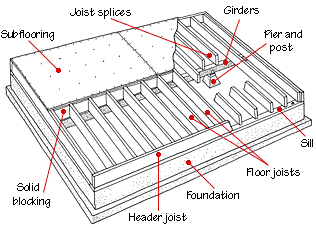
The next challenge for you is to find the floor joists. If you don’t already know the placement of the floor joists, you should get professional help. The installation of the gun safe can depend a lot on the placement and the distance between the joists. Once you know the location of the joists, you can go ahead with the installation of the gun safe.

While anchoring the gun safe to the wooden floor joists, you should use a lag bolt. Standard lag bolts have a hex head which can be installed with a socket wrench. You will need the entire socket wrench since the Phillip or slot head won’t do the job.

The best way of bolting the gun safe to the wooden floor is to drill into the floor first. This will prevent the cracking of the floor. You can then apply oil or soap to the bolt before anchoring it to the floor using a washer.
Bolting a Gun Safe to a Subfloor
Bolting a gun safe to a subfloor can be trickier than bolting it to the floor joists. The main risk in anchoring the gun safe to the subfloor is that the burglars can use the pry tools to rip off the safe by rocking and tilting. To add to the security of the gun safe, you can add more screws to the bottom of the gun safe.
To do this, you need to put a solid material in between the gun safe and the wooden floor. You will anchor the solid material to the wooden floor with multiple anchor holes as compared to the four bolts of the gun safe. You will then bolt the gun safe to the solid material using the four bolts.
You can either make your own solid fixture or get a carpenter to do it for you. You can also buy one if you want a quick solution. Make sure the metal fixture is at least as thick as five threads of your gun safe anchor bolts. If you’re using softer material like aluminum, you will need to go even thicker.
Cut the fixture to the size of the base of the gun safe. It will be fine if the fixture is larger than the bottom of the safe, but it shouldn’t be smaller. If the fixture is smaller than the gun safe, it will give an opening to the burglars to put a pry tool in the opening and tip the safe over.
You then need to mark the gun safe for the four anchor bolts. Drill and adjust the anchor holes. The bolts should be long enough so they go through the washer, the gun safe, the metal fixture and reach the floor.
Now, drill the metal sheet for the bolts which will be used to anchor the metal fixture to the floor. The optimum way is to drill a hole every 4-8 inches in the perimeter of the metal. While drilling, make sure the screws don’t stick up through the metal fixture since they can damage the gun safe and make it unstable.
The last part, screw the metal fixture to the floor. After bolting the metal fixture, set up the gun safe on the fixtures and install the anchors from inside the gun safe.
Anchoring A Gun Safe To A Wall
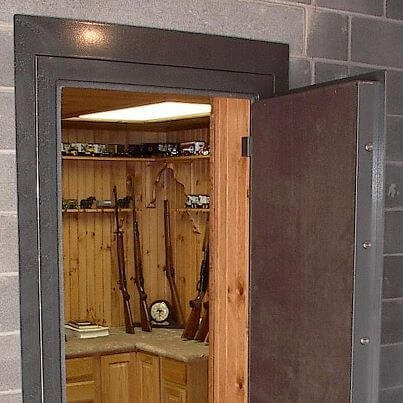
Anchoring a gun safe to a wall will require you to drill through the walls of the gun safes. A big problem with anchoring the gun safe to a wall is that it is hard to determine the right place to drill in the wall. There is a lot happening inside the walls of your house. There might be many pipes and wires running inside them. Drilling through even single one of them can create chaos.
The gun safe manufacturers recommend anchoring the gun safes to the floors. The biggest reason behind it is the fact that the door and the body of the gun safe can go out of alignment if the gun safe goes out of alignment.
Drilling through the walls of the gun safe can damage the fire proofing of the gun safe. The anchor holes in the bottom of the gun vault are the safest during a fire. This makes sure the gun safe is bolted to the place even in the case of a fire breakout.
You also need to maintain some distance between the wall and the gun safe while anchoring the gun safe. This space can give an opening for the burglars to put in their pry tools and rip it off the wall.
Anchoring to a wall should ideally be an option for people who don’t have a place to anchor their gun safes to the floor or for the people who have post tension concrete slabs.
Availability of Electrical Connections
If you’re installing your gun safe in a place where there is excessive humidity (refer to the table at the top) or if it is too dark, you will need some electrical connections. Most gun safes come with a provision for an electrical connection to power a light inside the gun safe or a connection point for a dehumidifier.
Humidity inside a gun safe can damage your guns and ammunition. While you can’t stop humidity, you can save your guns from it by installing a dehumidifier inside your gun vault. A dehumidifier is also a must if you’re planning to store other valuables like jewelry, cash and other important papers inside your safe.
Convenience and Easy Access
If you install the gun safe in a place which is too hard to reach, you will end up abandoning it after some time. Convenience and easy access play an important role in determining how much you will use your gun safe.
If you install your gun safe in a place where you can see it every day, you will use it often and chances are you might even run out of space in it. Some people get a big gun safe in anticipation of heavy use but install the gun safe in a far off place where it is hard to reach. Most of the space may go underutilized.
Before setting up your gun safe you need to think about how many times in a day are you planning to use the gun safe. What are the things you will be storing in it? Do you also want to keep your gun safe out of the reach of children and other people in your home?
At the same time, you need to think like a burglar. You need to figure out where a burglar would look first for valuable things. You also need to check the time it would take the burglar to carry away your gun safe out of the house from the place you’re thinking to anchor it to.
While you’re at it, don’t try to think outside the box. A place too far away from your living room or bed room can prove to be inaccessible in the long run. Install your gun safe in a place you can walk up to without the need to think about it twice or otherwise your gun safe is going to eat dust.
Best Place To Put A Gun Safe For Humidity and Temperature Protection
Gun safes are enclosed structures and pretty much have the same humidity and temperature inside the safe as outside the safe. You shouldn’t expect your gun safe to have a different temperature than the place you store it in. The only way to control the temperature and humidity inside the gun safe is to use electrical equipment like a dehumidifier.
For the longevity of your guns it is important you store your guns in a humidity and temperature controlled environment. Places like your garage and basements can expose your firearms to excessive humidity which can destroy your guns. Your upper floors, on the other hand, might be exposed to overheating in the summer, which can again cause harm to your arms.
Similarly, keep your gun safes away from fire places, chimney, and your kitchen. You need to put your gun safes in temperature controlled areas. Gun safes have the longest life in places like your living room, bed room, and office where the temperature and humidity are controlled.
Best Place To Put Your Gun Safe For Theft Protection
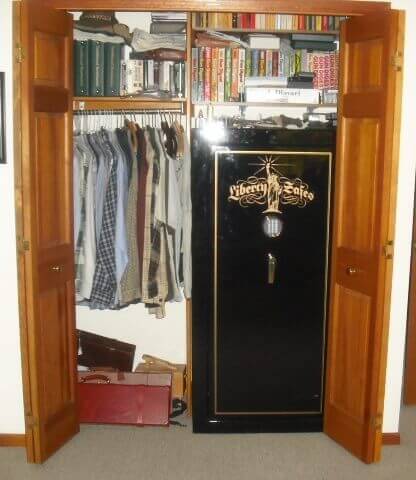
1. Bed Room
If your bed room is hard to access, there can only be a few other better places in your house to store a gun safe. Most people won’t come near your gun safe just because it is in your bedroom which is considered to be a personal space.
Sadly, burglars head to the master bed room after breaking into a house. They know if there is anything valuable in your house, it should be in your bedroom. If the thieves don’t find anything valuable, they head to the other bedrooms in the house.
2. Closets
After entering the bedrooms, the closets are the second option for the thieves. Many people consider closets to be a safe place to install safes. Unfortunately, burglars think the same way. This is the reason they go for the closets and dressing the first thing after entering a bedroom.
Though closets can provide ultimate safety to your gun safe if you install it between two exterior walls. It takes out any space for the burglars to put in a pry tool and to try to tip over the gun safe.
3. Living Rooms
You shouldn’t install your gun safe at a place where it is visible to people. A place where the gun safe is visible from the front door or the back door is a big no. Avoid installing the gun vault at places where it is visible from the outside through the windows since it might end up drawing unwanted attention.
4. Office
If you have an office at home, it wouldn’t be a good idea to store your gun safe there. A home office can be a sign of wealth and power, and it might become the primary target of a burglar.
On the other hand, if you have an office in a commercial building with guards on duty, your gun safe might be in good hands. All you need to worry about are the employees looking to make an extra dollar off of you.
5. Garage
Gun safes in garages can have many advantages and disadvantages. Most garages have concrete floors which make for a great surface to anchor your gun safes. As we discussed earlier, anchoring your gun safe to a concrete slab can eliminate any space for a thief to put in a pry tool and pop it open.
On the negative side, garages are not humidity or temperature controlled. If you don’t control the environment of the gun safe manually, it can end up damaging your guns. Most people have a garage which can be scanned from the outside when it is open.
Since it is a garage, most people also store in their tools there. These tools can act as an aid for the thieves. Just make sure you install your gun safe in the garage where people can’t see it when the garage door is opened.
6. Basements
Basements can be one of the safest places in your house to store a gun safe. A basement isn’t also one of the first places a thief goes to when he enters a house. There is a reason behind it. No one wants to climb the flight of stairs carrying a gun safe.
Burglars would love for you to store your gun safe on higher floors since all they need to do is throw it down the stairs. Other than the humidity and temperature in the safe, the basement is a great place to install your gun safe. The only problem is, people tend to store their hand tools in their basements. Easy access to hand tools can make it easier for the burglars to open the safe.
The best place to store your gun safe inside the basement is to put it between two walls. This will restrict what a burglar can do to rip the gun safe from the ground. Make sure the anchor holes are completely bolted in the concrete slab in the ground.
Best Place For Flood Protection
You need to prepare for floods no matter how far away you live from a water body. While storing the gun safe in a basement can be one of the best options, it is the complete opposite in this case. Basements are one of the first places to be flooded in the case a river overflows.
To save your gun safe from a flood, store it as high from the ground level as possible. Don’t be too dependent on appliances like water pumps to eliminate the water from your house. The water pumps might fail in such situations and you can end up with big losses.
Best Place For Fire Protection
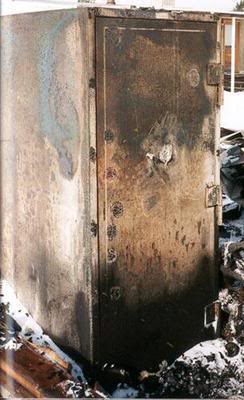
As a rule of thumb, the farther a gun safe is from the source of fire, the lesser damage it will face. Storing a gun safe in the kitchen could be a bad idea since your gun safe can be prone to be caught in the middle of a fire if it breaks out of the kitchen. You shouldn’t also be storing your gun safe in a room directly above or under the kitchen.
Similarly, storing your gun safe in your smoking room or near the fireplace can be a bad idea. You also don’t want to store your gun safe in your garage as it can have flammables like gasoline for the lawn mowers, chemicals, thinners and gas in the cars. The flammables can make the already existent fire worse or can even start a fire on their own.
The lower floors like the ground floor and the basement are the safest in cases of a fire break out since they are the coolest. Higher floors are generally hotter than the lower floors, especially in the summer and can cause extra damage to your gun safe.
Another risk of storing your gun safe on higher floors is, in cases of severe fires, your gun safe might fall through the floors into the lowest floor or the basement and can incur significant damage on impact.
Since in the case of fire, water that is used to extinguish fire can cause additional damage to your safe. In most fire cases whatever is left in the basement is not recovered. A bulldozer is used to flatten out the basement.
Your best bet against fire protection can be to buy a gun safe which is UL approved to be fire protected. These UL certified gun safes can stand up to one hour in fire without incurring any damages to the contents of the safe.
Where To Store Things Inside A Gun Safe
We hope this article has helped you find the right place for you to put your gun safe. Now the next task is to find the right place to store your guns and other valuables inside a gun safe. Different parts of a gun safe have different protection levels against fires and floods and you should know about it before storing your guns in the vaults.
While storing things inside a gun safe, think of the vault as a home. The higher shelves of the gun safe are hot and the lower shelves are relatively cooler. According to this, storing your valuables at the bottom of the safe will be the best option to protect against fires. On the other hand, the lower shelves of the gun safes are the most prone to floods.
Storing your most valuable guns in the middle and the lower shelves of the gun safe will be the safest option. You can store your least valuable guns at the top of the gun safe. If you have limited stuff to put inside the gun safe, use the middle and lower shelves first and then move onto the upper shelves.
Also, stay away storing flammables inside your gun safe. Don’t store ammunition inside your gun safe. Ammo has a high chance of catching fire in hot circumstances. If you have no other place to put your ammo in, store them in the bottom of your gun safe. The bottom of the gun safe is the coolest place inside a gun safe and ammo is relatively waterproof.
Where To Put A Handgun Safe
Most of what we covered in this article applies to bigger gun safes like true gun safes and residential security containers (RSCs). Since these gun safes are bulky and heavy, they might provide more protection as compared to the handgun safes.
Most handguns are compact. Pay extra care while installing them since they’re more prone to unauthorized access and will be easier to pry free since they weigh significantly less than the big gun safes.
1. Put It in a Convenient Place
Since a handgun safe can only hold a couple of guns, you should store them in a convenient place so you can reach to them in time of emergency. At the same time, you need to make sure the gun safe is not visible to everyone.
2. Keep It Away From Children
If you have children at home, you should store your handgun safe at a place where children can’t reach it. Installing it in a high place is the best option if you have small children.
3. Bolt The Gun Safe
Letting the gun safe lie around at your home or office is ill advised. You should bolt your gun safe to a wall or floor. Doing this adds a layer of security to the safe as it makes it harder for the burglars to steal it.
This is all you should know about before you decide on a location to install your gun safe.
It is now time to know how to pick the best gun safe.
